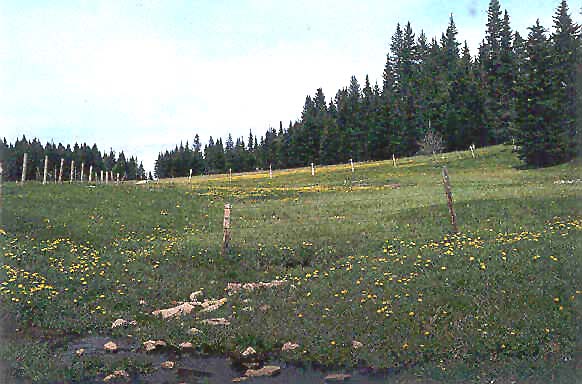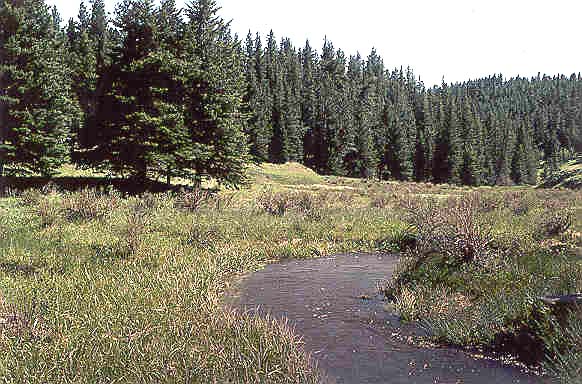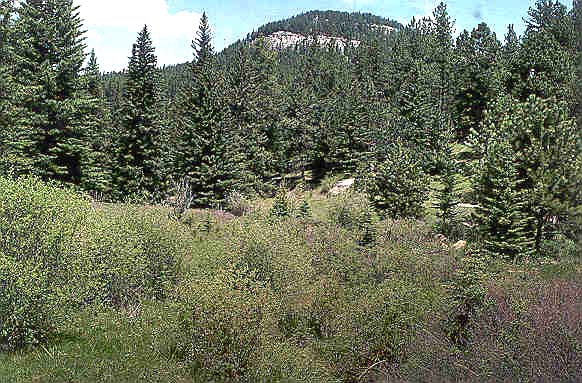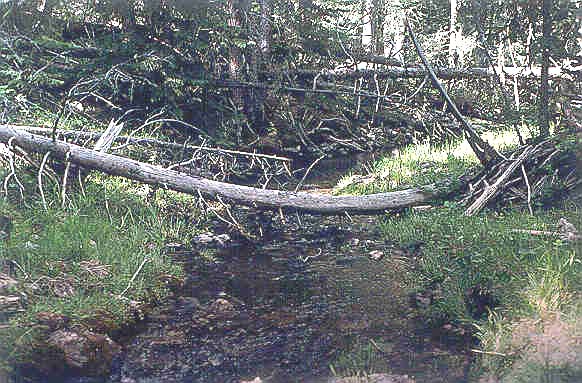Hydrologic Benchmark Network Stations in the West-Central U.S. 1963-95 (USGS Circular 1173-C)
|
|
|
|
|
Castle Creek above Deerfield Reservoir, South Dakota (06409000)
Hydrologic Benchmark Network Stations in the West-Central U.S. 1963-95 (USGS Circular 1173-C)
|
|
|
|
|
Castle Creek above Deerfield Reservoir, South Dakota (06409000)
To download a printer friendly PDF version of this information click here.
This report details one of the approximately 50 stations in the Hydrologic Benchmark Network (HBN) described in the four-volume U.S. Geological Survey Circular 1173. The suggested citation for the information on this page is:
|
Clark, M.L., Eddy-Miller, C.A., Mast, M.A., 2000, Environmental characteristics and water-quality of Hydrologic Benchmark Network stations in the West-Central United States, U.S. Geological Survey Circular 1173-C, 115 p. |
All of the tables and figures are numbered as they appear in each circular. Use the navigation bar above to view the abstract, introduction and methods for the entire circular, as well as a map and list of all of the HBN sites. Use the table of contents below to view the information on this particular station.
|
Table of Contents |
| 1. Site Characteristics and Land Use |
| 2. Historical Water Quality Data and Time-Series Trends |
| 3. Synoptic Water Quality Data |
The Castle Creek HBN Basin is within the Black Hills Section of the Great Plains physiographic province (Fenneman, 1946) in southwestern South Dakota (Figure 21. Map showing study area in Castle Creek Basin and photograph of Silver Creek). The HBN station is about 4 km southwest of the dam on Deerfield Reservoir and about 23 km northwest of Hill City, S. Dak., at a latitude of 44×00'49'' and a longitude of 103×49'48''. Castle Creek drains 205 km² of dissected, mountainous terrain. Elevations in the basin range from about 1,800 to about 2,170 m. The average stream slope is about 15 m/km (S.K. Sando, U.S. Geological Survey, written commun., 1998). The ecoregion of the basin is classified as the Black Hills Coniferous Forest Province (Bailey, 1995). A moderately dense Ponderosa pine forest covers most of the basin, and spruce, aspen, willows, and smaller trees and brush grow in the valley areas. Some of the valley floors have been cleared for pastures. Castle Creek is tributary to Rapid Creek, which drains into the Cheyenne River.
 |
The Black Hills are a dome-shaped uplift, dissected by streams. The central core rocks of the Black Hills underlie the area near the HBN station and are composed of Precambrian micaceous schist and phyllite. The upstream part of the Castle Creek HBN Basin drains predominantly Paleozoic carbonate rocks of the Limestone Plateau, including the Madison Limestone of Mississippian age, an important regional aquifer. Lithologic types are cliff-forming dolomitic limestones, dolomites, limestones, shale, and siltstone (DeWitt and others, 1986; DeWitt and others, 1989). Important characteristics of the Madison Limestone, locally known as the Pahasapa Limestone, are its karstic features, including numerous fractures, solution cavities, and springs. The caverns of Jewel Cave National Monument and Wind Cave National Park formed in the Madison Limestone, south and east of the Castle Creek HBN Basin. The Madison is a key factor in the surface-water hydrology of the Black Hills area. Many streams lose all or part of their flow to the sinkholes; resurgent springs are located farther downstream (Driscoll, 1992). The soils in the basin are silty, generally deep, well drained, and gently sloping to steep. Soils are formed in materials weathered from limestone (U.S. Department of Agriculture, 1990). There is very little alluvium in the stream valleys.
 |
The Castle Creek HBN station is in Pennington County. The basin lies entirely within the Black Hills National Forest, although some of the land along the valley floors is privately owned. Much of the drainage area can be accessed by improved paved roads and light-duty gravel and dirt roads. Foot trails provide access to areas farther up the drainages. The HBN station can be accessed by vehicle during all seasons, weather permitting. Manmade features in the basin include a gravel pit, roads, trails, and a campground. An established Forest Service campground is in the Ditch Creek drainage. Timber harvest has occurred one or more times throughout the basin. Cattle and horses graze throughout the basin. Hay and oats are grown in the pastures along the valley bottoms. Recreational uses in the basin include four-wheel-drive vehicle use, fishing, hiking, hunting, and camping. Winter recreation in the upper basin includes skiing and snowmobiling. The basin sees substantial tourism because of its location within the popular Black Hills and its close proximity to Mount Rushmore National Monument. There is a gravel mine in the South Fork Castle Creek drainage, and Black Hills gold is mined lower in the Castle Creek drainage downstream from the HBN study area.
The data set analyzed for the Castle Creek HBN station includes 240 water-quality samples that were collected from December 1964 through August 1995. Sampling frequency is described on the basis of water year, which begins on October 1 and ends on September 30. Sampling frequency was quarterly from 1965 through 1967 and increased to 10-13 samples collected annually during the period 1968 to 1982. After 1982, samples generally were collected quarterly. Samples were analyzed at USGS district water-quality laboratories until the early 1970's. After 1973, with the creation of the USGS Central Laboratory System, all samples were analyzed at the water-quality laboratory (now called NWQL) in Arvada, Colo. The period of record for discharge is from water year 1948 to current year (2000). Daily water temperature was recorded from May 1964 to September 1984.
 |
[Parameters in units of microequivalents per liter, except for discharge in cubic meters per second, specific conductance in microsiemens per centimeter at 25 degrees Celsius, pH in standard units, and silica in micromoles per liter; n, number of stream samples; VWM, volume-weighted mean; spec. cond., specific conductance; --, not reported; <, less than]
|
Parameter |
Stream Water |
Precipitation VWM |
|||||
|
Minimum |
First quartile |
Median |
Third quartile |
Maximum |
n |
||
| Discharge |
0.06 |
0.26 |
0.31 |
0.40 |
1.2 |
240 |
-- |
| Spec. cond., field |
304 |
439 |
467 |
485 |
715 |
239 |
-- |
| pH, field |
7.2 |
8.1 |
8.3 |
8.5 |
9.6 |
237 |
5.3a |
| Calcium |
1,200 |
2,600 |
2,800 |
2,900 |
3,400 |
240 |
15 |
| Magnesium |
1,600 |
2,400 |
2,500 |
2,600 |
2,900 |
239 |
2.9 |
| Sodium |
22 |
61 |
65 |
83 |
240 |
237 |
3.0 |
| Potassium |
18 |
28 |
31 |
38 |
110 |
238 |
.87 |
| Ammonium |
<.7 |
.7 |
1.4 |
4.3 |
14 |
72 |
13 |
| Alkalinity, laboratory |
3,000 |
4,700 |
5,000 |
5,200 |
5,800 |
239 |
-- |
| Sulfate |
6.2 |
120 |
150 |
170 |
460 |
239 |
18 |
| Chloride |
5.6 |
25 |
34 |
42 |
230 |
236 |
2.5 |
| Nitrite plus nitrate |
<.7 |
7.1 |
8.6 |
15 |
23 |
114 |
15b |
| Silica |
1.7 |
140 |
150 |
160 |
180 |
239 |
-- |
a Laboratory pH.
b Nitrate only.
The median and range of major-ion concentrations in stream water collected at the Castle Creek HBN station and VWM concentrations in wet precipitation measured at the Newcastle, Wyo., NADP station are presented in table 40. The NADP station is about 43 km southwest of the HBN station. Precipitation chemistry at the NADP station was dilute and slightly acidic with VWM pH of 5.3 during the period of record, 1981-95. The dominant cation in precipitation was calcium, accounting for about 38 percent of the cation concentration. About 33 percent of the total cation concentration was contributed by ammonium. Sulfate and nitrate contributed about 51 and 42 percent, respectively, to the total anion concentration in precipitation.
Stream water in Castle Creek is an alkaline, calcium bicarbonate type. The sum of ion concentrations ranged from about 7,600 to about 12,000 meq/L. Alkalinity ranged from 3,000 to 5,800 meq/L, and bicarbonate was the primary contributor to alkalinity at this station. Dissolved calcium and magnesium contributed over 98 percent of the median cation concentration in stream water, and bicarbonate contributed 96 percent of the median anion concentration. The predominance of these constituents is typical of a geologic setting containing limestones and dolomites. Carbonate rocks generally are more soluble than silica-rich rocks, including sandstones, granite, and schists; greater solubility of rock increases dissolved-solids concentrations in streams (Biesecker and Leifeste, 1975). Specific conductance (304 to 715 mS/cm) is an indicator of dissolved solids at this station. Median concentrations of ammonium and nitrate were lower in the stream water than in the precipitation, indicating that nitrogen generally is retained by the biomass in the basin.
[Q, discharge; Ca, calcium; Mg, magnesium; Na, sodium; K, potassium; Alk, alkalinity; SO4, sulfate; Cl, chloride; SiO2, silica; --, not applicable]
|
|
Q |
pH |
Ca |
Mg |
Na |
K |
Alk |
SO4 |
Cl |
| pH |
-0.086 |
-- |
-- |
-- |
-- |
-- |
-- |
-- |
-- |
| Ca |
-.224 |
0.140 |
-- |
-- |
-- |
-- |
-- |
-- |
-- |
| Mg |
-.244 |
.138 |
0.404 |
-- |
-- |
-- |
-- |
-- |
-- |
| Na |
.011 |
.056 |
.068 |
0.084 |
-- |
-- |
-- |
-- |
-- |
| K |
.095 |
-.128 |
.115 |
-.058 |
0.278 |
-- |
-- |
-- |
-- |
| Alk |
-.208 |
-.004 |
.702 |
.307 |
.097 |
0.197 |
-- |
-- |
-- |
| SO4 |
.217 |
.153 |
.126 |
.081 |
.158 |
.100 |
0.039 |
-- |
-- |
| Cl |
.055 |
-.112 |
.113 |
-.057 |
.138 |
.172 |
.192 |
0.156 |
-- |
| SiO2 |
-.084 |
-.350 |
.299 |
.227 |
.024 |
.376 |
.270 |
-.053 |
0.088 |
Correlations among dissolved constituents and discharge were determined for Castle Creek (table 41). Base cations and anions showed weak and mixed, positive and inverse correlations with stream discharge. The lack of strong correlations with discharge probably is due to the narrow range of discharge associated with the well-drained soils and the karstic nature of underlying carbonates, which allows precipitation to infiltrate quickly. The magnitude of the minimum values
 |
Results of the seasonal Kendall test for trends in discharge and major dissolved constituents for Castle Creek from 1965 through 1995 are presented in table 42. Statistically significant upward trends (a = 0.01) occurred in pH, calcium, and alkalinity. A significant downward trend in unadjusted silica concentrations was observed. After the statistical test was adjusted for discharge, only the upward trends remained in concentrations of calcium and alkalinity. This indicates that stream discharge may have been controlling the pH and silica trends, but not the calcium and alkalinity trends. Regional precipitation chemistry shows a widespread decline in calcium concentrations for the period 1980-92 (Lynch and others, 1995). The decrease in calcium in precipitation is not consistent with the upward trend in calcium in stream water. However, carbonate rock rather than precipitation is the predominant control on the calcium in the stream water. Variations in timber harvest is one land-use change that has occurred in the basin.
[Trends in units of microequivalents per liter per year, except for discharge in cubic meters per second per year, pH in standard units per year, and silica in micromoles per liter per year; p-value, attained significance level; --, not calculated; <, less than]
|
Parameter |
Unadjusted |
Flow adjusted |
||
|
Trend |
p-value |
Trend |
p-value |
|
| Discharge |
-0.01 |
0.592 |
-- |
-- |
| pH |
.01 |
<.001 |
(b) |
-- |
| Calcium |
10 |
<.001 |
9 |
<0.001 |
| Magnesium |
<.01 |
.018 |
3 |
.048 |
| Sodium |
<.01 |
.327 |
(b) |
-- |
| Potassium |
-.2 |
.013 |
(b) |
-- |
| Alkalinity |
10 |
.001 |
9 |
.003 |
| Sulfate |
-.6 |
.122 |
-0.4 |
.188 |
| Chloride |
<.01 |
.750 |
(b) |
-- |
| Nitrite plus nitrate a |
<.01a |
.306 |
-- |
-- |
| Silica |
-.3 |
.002 |
(b) |
-- |
a Trend test for highly censored data was used.
b Concentration-flow model not significant at a = 0.10.
An upward trend in flow-adjusted sulfate concentrations and increasing levels of sulfur-dioxide emissions were reported by Smith and Alexander (1983) for the mid- to late 1960's to 1981. Annual precipitation and runoff data for Castle Creek indicate that evapotranspiration can account for about a tenfold increase in stream-water concentrations compared to precipitation, which indicates precipitation is the primary contributor of sulfate in stream water. The lack of a trend for the period 1965-95 indicates that sulfate deposition may have decreased in the area since that study.
Results of a surface-water synoptic sampling conducted June 12-14, 1993, in the Castle Creek Basin are presented in table 43, and locations of the sampling sites are shown in figure 21. Discharge at the HBN station (site 13) was 0.96 m³/s compared to the mean monthly discharge of 0.40 m³/s for the month of June (Burr and others, 1996). The sum of ions ranged from 1,100 (site 2) to 11,000 meq/L at several sites, including the HBN station (site 13). Concentrations of dissolved constituents in tributaries and springs generally were within the range of dissolved constituent concentrations for the Castle Creek HBN station (table 40) with the exception of site 2, which had a smaller concentration of calcium, magnesium, and bicarbonate than the minimum value recorded at the HBN station. Water in the basin is generally a calcium-magnesium bicarbonate or calcium bicarbonate type. Water sampled from the tributaries and springs were near neutral to alkaline. The percent difference of cations and anions ranged from 0.1 to 7.1 percent for all sites, indicating that unmeasured ions did not contribute substantially to the ionic composition of the water.
[Site locations shown in fig. 21; Q, discharge in cubic meters per second; SC, specific conductance in microsiemens per centimeter at 25 degrees Celsius; pH in standard units; Ca, calcium; Mg, magnesium; Na, sodium; K, potassium; Alk, alkalinity; SO4, sulfate; Cl, chloride; NO3, nitrate; SiO2, silica; concentrations in microequivalents per liter, except silica is in micromoles per liter; --, not measured; <, less than; criteria used in selection of sampling sites: BG = bedrock geology, TRIB = major tributary]
|
Site |
Identification number |
Q |
SC |
pH |
Ca |
Mg |
Na |
K |
Alk |
SO4 |
Cl |
NO3 |
SiO2 |
Criteria |
|
1 |
440650103570000 |
-- |
458 |
7.8 |
3,800 |
1,500 |
52 |
44 |
5,000 |
25 |
<2.8 |
7.5 |
350 |
BG |
|
2 |
440414103583000 |
-- |
50 |
7.2 |
380 |
100 |
52 |
49 |
480 |
8.3 |
17 |
2 |
230 |
BG |
|
3 |
440521103571600 |
-- |
407 |
-- |
2,800 |
1,800 |
39 |
14 |
4,400 |
58 |
8.5 |
37 |
180 |
BG |
|
4 |
440400103521100 |
-- |
476 |
8.3 |
2,800 |
2,500 |
52 |
22 |
5,300 |
56 |
14 |
6.4 |
150 |
BG |
|
5 |
440156103504300 |
0.39 |
483 |
8.4 |
3,000 |
2,300 |
61 |
31 |
5,200 |
180 |
34 |
4.9 |
160 |
TRIB |
|
6 |
440148103504100 |
.04 |
481 |
8.5 |
3,000 |
2,500 |
57 |
28 |
5,300 |
100 |
17 |
6.9 |
140 |
TRIB |
|
7 |
440055103495900 |
.55 |
491 |
8.4 |
3,100 |
2,400 |
78 |
33 |
5,200 |
230 |
62 |
7.8 |
170 |
TRIB |
|
8 |
435930103521900 |
.02 |
463 |
8.4 |
3,200 |
2,100 |
48 |
19 |
5,000 |
56 |
45 |
4.8 |
130 |
BG |
|
9 |
435847103513900 |
.01 |
460 |
8.5 |
3,000 |
2,200 |
57 |
31 |
5,100 |
63 |
17 |
4.9 |
150 |
TRIB |
|
10 |
435832103504400 |
.09 |
477 |
8.5 |
3,200 |
2,200 |
52 |
20 |
4,900 |
65 |
31 |
9.5 |
150 |
TRIB |
|
11 |
435856103500000 |
.06 |
501 |
8.4 |
2,800 |
2,600 |
87 |
72 |
5,400 |
200 |
25 |
1.6 |
160 |
BG |
|
12 |
440039103495100 |
.25 |
449 |
8.5 |
2,800 |
2,200 |
87 |
46 |
4,600 |
120 |
25 |
1.9 |
170 |
TRIB |
|
13 |
06409000 |
.96 |
476 |
8.5 |
3,000 |
2,300 |
83 |
36 |
5,100 |
190 |
51 |
6 |
170 |
-- |
Two samples that were collected in the headwaters of the Castle Creek drainage were from springs (sites 1 and 2). The first location of sustained flow in the Castle Creek channel was noted at site 3. The concentrations of constituents were more dilute in Badget Ranch Spring (site 2). The exact location of the contact between the Madison Limestone and the Minnelusa Formation of Permian age is unknown in the area near this spring. The Minnelusa Formation includes sandstone, breccia, limestone, and shale. The geochemical composition of the Badget Ranch sample is more characteristic of a geologic environment containing silica-rich rocks like the Minnelusa Formation than a predominantly limestone environment. The different water quality at the two springs also could be the result of different residence time. Samples that were collected from areas draining metamorphosed tuffaceous shale tend to have higher concentrations of sodium and sulfate (sites 7, 11, 12, and 13). Precipitation chemistry can account for the nitrate concentrations in samples that were collected during the synoptic sampling.
Bailey, Robert G., 1995, Descriptions of the ecoregions of the United States: U.S. Department of Agriculture, Forest Service, Miscellaneous Publication 1391, 108 p.
Biesecker, J.E., and Leifeste, D.K., 1975, Water quality of hydrologic benchmarks-An indicator of water quality in the natural environment: U.S. Geological Survey Circular 460-E, 21 p.
Burr, M.J., Teller, R.W., and Neizert, K.M., 1996, Water resources data, South Dakota, water year 1995: U.S. Geological Survey Water-Data Report SD-95-1, 379 p.
DeWitt, Ed, Redden, J.A., Busher, David, and Wilson, A.B., 1989, Geologic map of the Black Hills area, South Dakota and Wyoming: U.S. Geological Survey Miscellaneous Investigations Series Map I-1910, 1 pl., scale 1:250,000.
DeWitt, Ed, Redden, J.A., Wilson, A.B., Buscher, David, and Dersche, J.S., 1986, Mineral resource potential and geology of the Black Hills National Forest, South Dakota and Wyoming: U.S. Geological Survey Bulletin 1580, 135 p.
Driscoll, D.G., 1992, Plan of study for the Black Hills hydrology study, South Dakota: U.S. Geological Survey Open- File Report 92-84, 10 p.
Fenneman, N.M., 1946, Physical divisions of the United States: Washington, D.C., U.S. Geological Survey special map, scale 1:7,000,000.
Lynch, J.A., Bowersox, V.C., and Grimm, J.W., 1995, Trends in precipitation chemistry in the United States-A national perspective, 1980-92: Atmospheric Environment, v. 29, no. 11. p. 1231-1246.
National Climatic Data Center, 1996, Summary of the day, CD-ROM: Boulder, Colorado, EarthInfo Incorporated.
Smith, R.A., and Alexander, R.B., 1983, Evidence for acid-precipitation-induced trends in stream chemistry at hydrologic benchmark stations: U.S. Geological Survey Circular 910, 12 p.
U.S. Department of Agriculture, 1990, Soil survey of Custer and Pennington Counties, Black Hills parts, South Dakota: U.S. Department of Agriculture, Soil Conservation Service, 295 p.
U.S. Geological Survey, 1982, Program and plan-National water-quality networks FY1983: Office of Water Quality Technical Memorandum No. 82.18, accessed December 27, 1999, at URL http://water.usgs.gov/ admin/memo/.
U.S. Geological Survey, 1983, Analytical methods-Sulfate determinations: Office of Water Quality Technical Memorandum No. 83.07, accessed December 27, 1999, at URL http://water.usgs.gov/admin/memo/.
a. U.S. Geological Survey topographic maps:
b. Geologic maps:
c. Soil surveys:
d. Other maps:
Table B-1. NWIS site-identification numbers and site names for water-quality sampling sites.
|
Site |
Identification Number |
Site Name |
|
1 |
440650103570000 |
Oatman Spring |
|
2 |
440414103583000 |
spring near Badget Ranch |
|
3 |
440521103571600 |
spring below Manganese Draw near Castle Creek headwaters |
|
4 |
440400103521100 |
Lyons Spring |
|
5 |
440156103504300 |
Castle Creek above Silver Creek |
|
6 |
440148103504100 |
Silver Creek |
|
7 |
440055103495900 |
Castle Creek above South Fork |
|
8 |
435930103521900 |
South Fork Castle Creek above Pole Creek |
|
9 |
435847103513900 |
Pole Creek |
|
10 |
435832103504400 |
Ditch Creek |
|
11 |
435856103500000 |
Heely Creek |
|
12 |
440039103495100 |
South Fork Castle Creek |
|
13 |
06409000 |
Castle Creek at gage |
| Back to 1173-C Contents |
This page maintained by Nichole Bisceglia.
Last updated July 31, 2000.